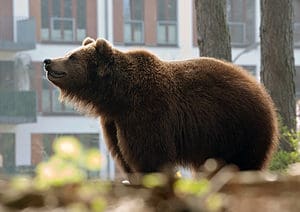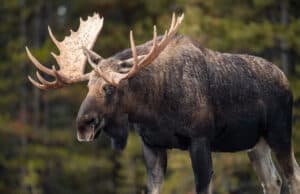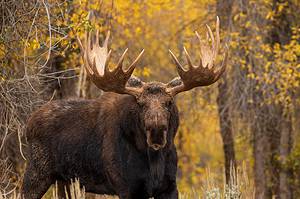North America is home to many interesting animals. Among these creatures are fierce predators and massive mammals, like wolves and moose. Wolves are deadly pack predators that roam the forests and tundra, hunting down prey by running them ragged. Moose are large mammals that also roam the forests and tundra alone unless they’re with their young. What happens if these two animals meet and battle it out in the wild? We’re going to show you what happens in a wolf vs moose fight and which animal emerges as the winner.
Comparing a Wolf and a Moose

| Wolf | Moose | |
| Size | Weight: 80-150lbs Length: 3.4ft – 5ft Height: 2.2ft – 3ft | Weight: 600lbs-1,500lbs or more Height: 4.6ft-6.9ft at shoulder Length 7ft-10ft |
| Speed and Movement Type | – 35 mph in short bursts – Uses a galloping sprint | 35 mph |
| Senses | A powerful sense of smell – Keen sense of vision with front -facing eyes like many predators. – Wolves can hear creatures from miles away. | – Near-sighted, so their hearing isn’t great – Great sense of smell – Very good sense of hearing |
| Defenses | – Safety in numbers in its pack – Speed to run away from danger | – Large bodies – Capable of running very fast – Good swimmers |
| Offensive Capabilities | – Powerful bite with 2-inch teeth – Sharp claws can lead to deep cuts | – Can stomp or kick – Will ram with antlers, causing trauma or severe punctures |
| Predatory Behavior | – Persistence hunting tires out the prey animal before killing it | – None, herbivorous – Territorial and aggressive at times, especially when rearing their young |
The Key Factors in a Fight Between a Wolf and a Moose
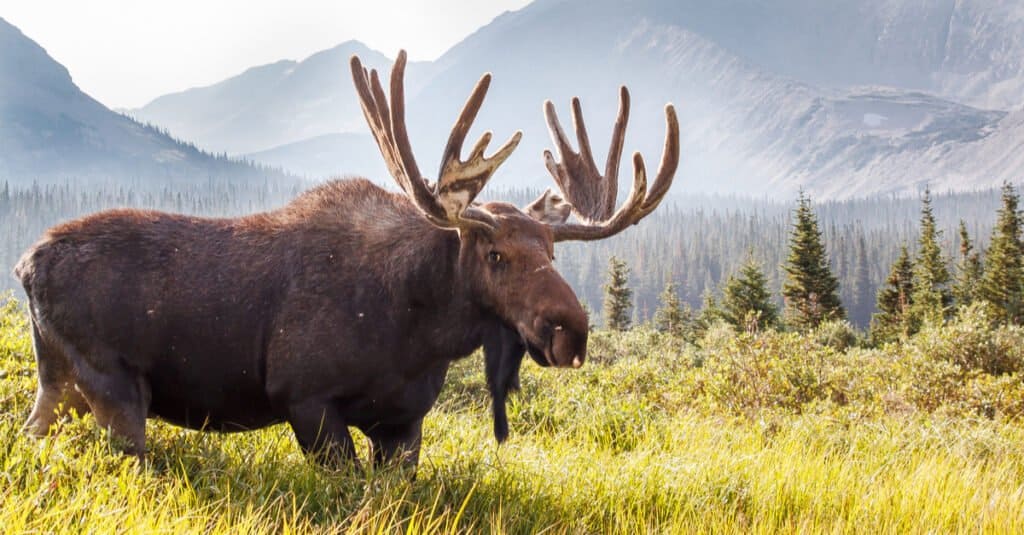
A fight between a moose and a wolf comes down to speed, power, and skill.
©Michael Liggett/Shutterstock.com
Size, speed, and offensive capabilities are the most significant factors in a fight between a wolf and moose. That is why we’re going to focus on these aspects of the animals by considering their physical capabilities as well as their fighting prowess.
Moreover, we will assign advantages to the animal that has superior qualities in each characteristic. By the time we’re done examining these creatures, the animal most likely to win will become apparent.
What Are 6 Key Differences Between a Wolf and a Moose?
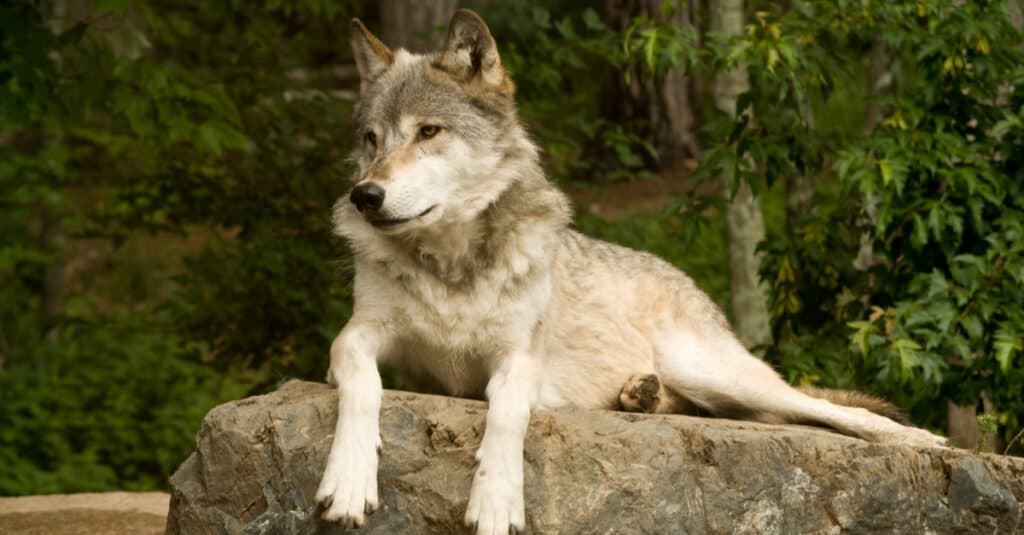
Wolves are smaller than moose, but they are far more effective at hunting
©Carol Heesen/Shutterstock.com
The biggest differences between a wolf and a moose are their size, socialization, and offensive capabilities. A wolf is much smaller than a moose, weighing up to 10 times less than the massive cervid.
However, wolves are social creatures that stay in packs throughout their lives and often use them to hunt down their prey. Moose are very solitary animals that usually only live together when they are raising their young or when it’s time to reproduce.
Lastly, wolves are highly capable killers with keen senses, strong fangs, and a powerful bite. Moose use antlers and throw their weight around with stomps to kill predators, but they don’t hunt others.
These are the biggest differences between a moose and a wolf, and they will all have a major impact on the fight.
Physical Features of a Wolf and a Moose
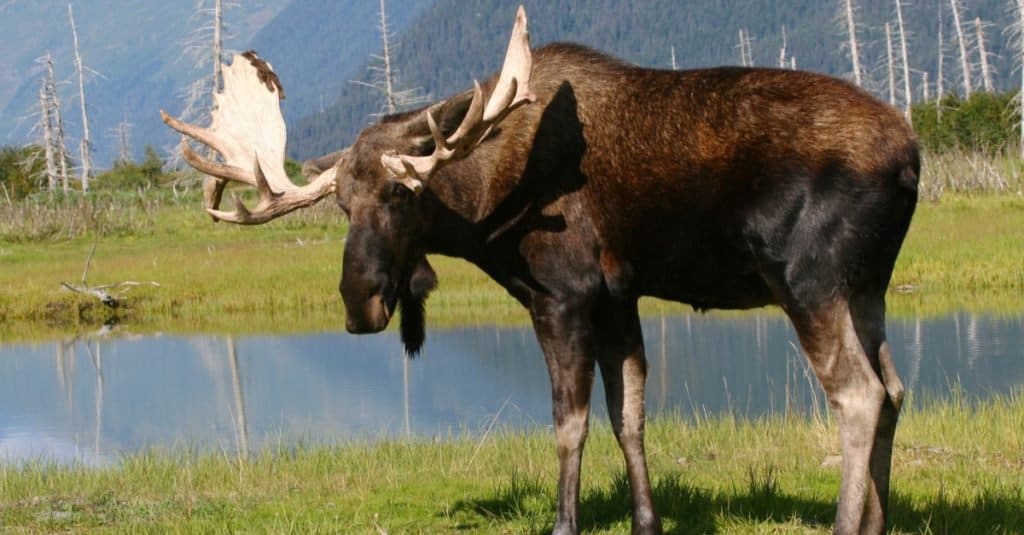
Moose are massive animals that regularly weigh over 1,000lbs
©Steve Bower/Shutterstock.com
Picking one creature to win a battle against the other requires a fine understanding of how they measure up to each other, literally and figuratively. That’s why we are going to look at their size, speed, senses, and physical defenses.
We’ll show you which animal has the advantage in each section and use that data in conjunction with an evaluation of their combat skills to determine who is going to win this bout.
Wolf vs Moose: Size
Moose are larger than wolves. The average wolf weighs up to 150lbs, grows about 5ft long, and reaches a height of about 3ft. However, moose weigh up to 1,500lbs or more, stand over 6ft tall, and grow about 10ft long.
Wolves are much smaller than moose, but we have to remember two factors. First, wolves hunt in packs and that can even the odds. Secondly, wolves have a lot of stamina and methods of attack.
Moose have a great size advantage.
Wolf vs Moose: Speed and Movement
Wolves and moose run at the same speed, roughly 35 mph. Wolves tend to harry their enemies rather than chase them down and kill them outright. So, they only run 35 mph to close the distance on their prey, harass them, and keep up the pace. Moose charge at 35 mph, but they can’t hold their speed as long as a wolf.
Moose and wolves are equal in speed.
Wolf vs Moose: Senses
Wolves have superior senses to moose. Wolves have a great sense of smell, wonderful vision, and hearing that allows them to detect animals from miles away. Moose lack good vision, but they have very strong senses of smell and hearing.
Wolves have the advantage in terms of senses.
Wolf vs Moose: Physical Defenses
Moose are better prepared for defense than wolves. Wolves have their pack safety and speed to outrun danger. Yet, moose have speed, massive bodies that are hard to attack, and they can quickly traverse land and water alike.
Moose have the advantage in physical defenses.
Combat Skills of a Wolf and a Moose
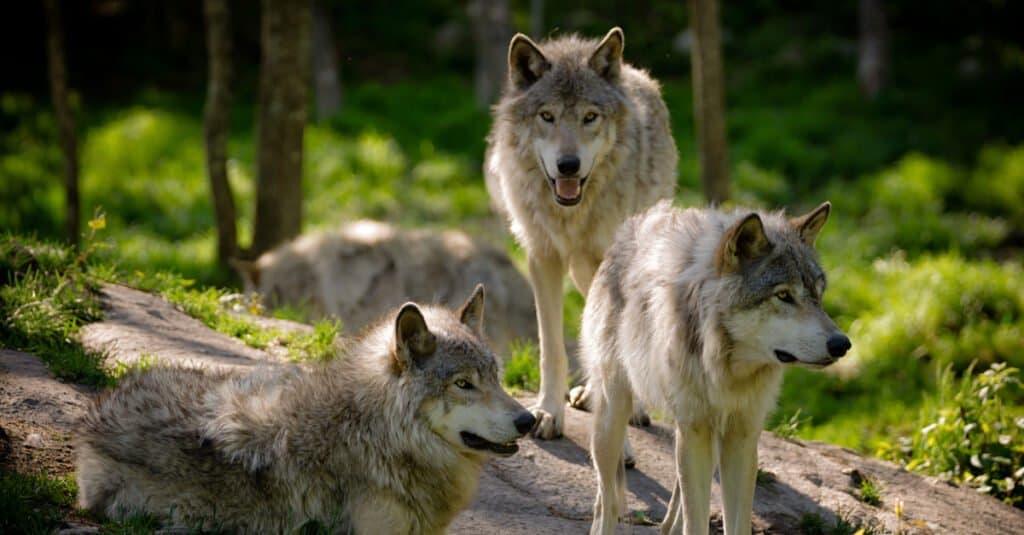
Wolves are pack animals that use persistence hunting to wear down enemies before they strike
©iStock.com/GatorDawg
A wolf is an effective killer, using claws, long teeth, and endurance to wear down enemies before inflicting fatal damage to them. A wolf has a strong bite that could achieve 1,000 PSI in the wild, and its jaws are strong enough to break bones. Wolves are very good hunters, especially when they’re in a pack.
Moose have multiple ways of fighting their foes. For one thing, they can kick in all directions, and their long legs help them keep predators away from their bodies. A single kick or stomp could be highly damaging if not fatal. Moose also use their antlers to attack predators, and those protrusions can batter or impale other animals.
All told, these animals are well-prepared for a battle.
Who Would Win in a Fight Between a Wolf and a Moose?
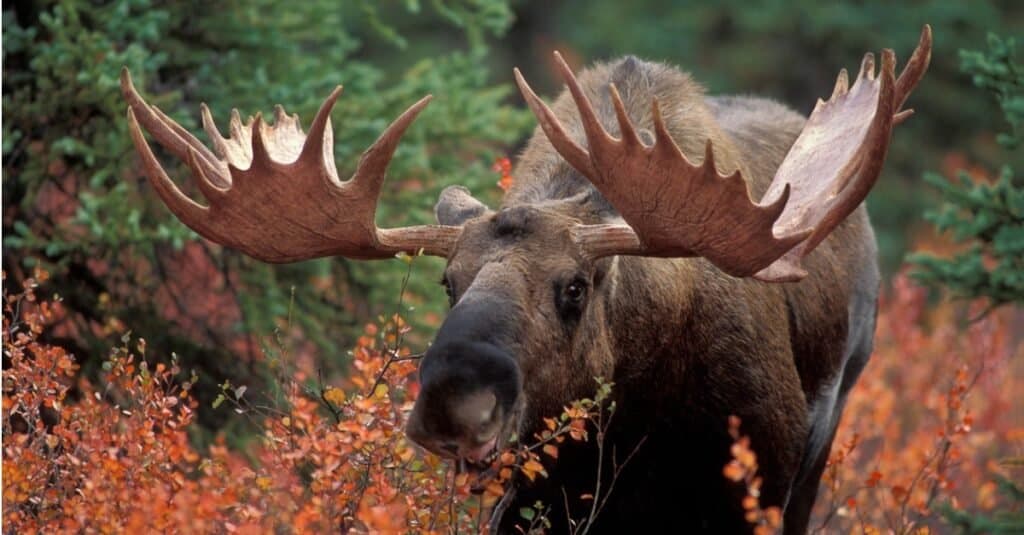
A moose is too large for a single wolf to overcome
©iStock.com/RONSAN4D
An adult moose will kill a single wolf in a fight. Cases exist where a single wolf has killed a moose, but they are usually juveniles if not calves. Tackling the challenge of a fully grown moose is more difficult for many reasons.
For starters, moose are very tall, and they use their antlers and legs to attack foes. That means a wolf has to imperil its life to get close enough to bite one. A single kick could knock a wolf out, and a stomp could end its life right then and there.
Meanwhile, a single wolf has to inflict fatal damage on a creature that weighs about five to ten times as much as it. Hitting vital areas will require running, leaping, and biting, exhausting the wolf’s energy. Of course, a wolf’s endurance is amazing, but that’s best utilized when they have enough pack members to snap at their prey’s heels and keep them moving. A single wolf is a target that a moose can watch and counter with relative ease.
For all these reasons, it seems unlike that an adult moose would lose a fight to such a small animal. Sure, it is possible that a wolf could land a fatal bite on the moose’s neck or another area, ending the fight in short order. Yet, it’s just as likely that the wolf would get hurt in the attempt.
The photo featured at the top of this post is © nataliatamkovich/Shutterstock.com
Thank you for reading! Have some feedback for us? Contact the AZ Animals editorial team.



